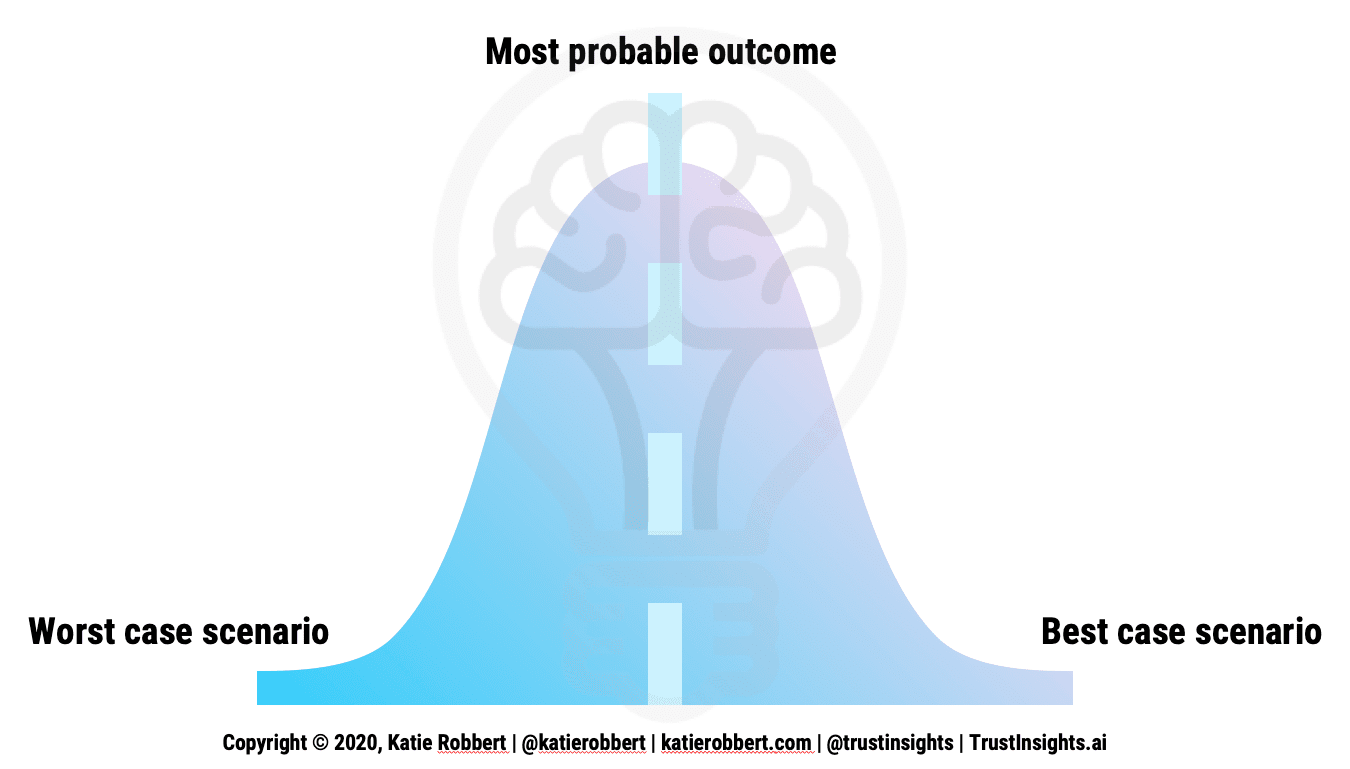What are your three plans?
In many conversations about planning, we often talk about the different types of plans we’ll need to account for various outcomes. My favorite style of planning is the three plans:
- Best case scenario
- Worst case scenario
- Most probable scenario
This seemingly straightforward planning framework fits a normal distribution – a bell curve – of outcomes and is the best way to plan for multiple eventualities.

The question then becomes, what constitutes these scenarios? After all, the worst case scenario could always be an undetected rogue asteroid wipes out all life on Earth tomorrow, but the probability of that happening, while not zero, is fairly close to zero. The realistic answer is to first decide on a goal you’re trying to achieve, then look at your own history and your competitors’ histories to see what has happened, and extrapolate from those results.
For example, suppose you’re launching a new webinar. In the past, you’ve attracted 250 registrants, but you’ve heard through the grapevine that a competitor landed 500 registrants for a similar topic. You’ve now got a sense of what the best case scenario could be – 500 registrants. The worst case probably isn’t zero, but if your worst webinar attracted 10 registrants, then that’s a reasonable potential worst case for this one. And if you took the average of the last 5 webinars you did and they netted out to 275 registrants, you’ve got a most probable scenario.
From this assessment, you can then build plans, resourcing, budgets, etc. to achieve each of the scenarios and obtain a decision from your stakeholders about which scenario they want the most. If the head office wants 500 registrants and you’ve outlined the budget and commitment to achieve that, they can now make a rational decision about whether the cost is worth the outcome or not.
Follow the three plans framework for any major decision, and you’ll be able to offer your stakeholders options instead of yes/no decisions that may increase the resources you’re given to work with.
The next step is to figure out the actions you’re going to take.
When I worked in-house on a product line we were constantly wanting to make changes to the software, adjust things, and fix issues. In order to get the approval we, the product owners, had to draft up a business case for why make the change was a priority. I learned very quickly that the risk assessment part of the document had the most impact. Essentially, not just what action are you going to take, but what happens if you choose this action?
Do nothing.
Those two words would carry the most weight when trying to determine if what we were proposing should get approved.
“If we do nothing, this is the likely outcome”
This could be anything from, “if we do nothing, the problem will persist and we will lose customers”, or, “if we do nothing, customers who use IE9 will have no issues but any potential customers who are using a newer web browser will not have an optimized experience”.
By outlining the “do nothing” scenario and associated risks, we were likely to get something approved, even if it was a minor change. You can liken it to “we’ve always done it this way” or “status quo” – basically, we’re complacent and are not invested in doing more to keep our customers happy.
When you’re planning out your scenarios, the “do nothing” version is just as important as the other action plans that you’re putting together. You may not have the funds or the resources to do something so understanding the risk of doing nothing will help you make your case.
What are you going to do?
|
Need help with your marketing AI and analytics? |
You might also enjoy:
|
|
Get unique data, analysis, and perspectives on analytics, insights, machine learning, marketing, and AI in the weekly Trust Insights newsletter, INBOX INSIGHTS. Subscribe now for free; new issues every Wednesday! |
Want to learn more about data, analytics, and insights? Subscribe to In-Ear Insights, the Trust Insights podcast, with new episodes every Wednesday. |
Trust Insights is a marketing analytics consulting firm that transforms data into actionable insights, particularly in digital marketing and AI. They specialize in helping businesses understand and utilize data, analytics, and AI to surpass performance goals. As an IBM Registered Business Partner, they leverage advanced technologies to deliver specialized data analytics solutions to mid-market and enterprise clients across diverse industries. Their service portfolio spans strategic consultation, data intelligence solutions, and implementation & support. Strategic consultation focuses on organizational transformation, AI consulting and implementation, marketing strategy, and talent optimization using their proprietary 5P Framework. Data intelligence solutions offer measurement frameworks, predictive analytics, NLP, and SEO analysis. Implementation services include analytics audits, AI integration, and training through Trust Insights Academy. Their ideal customer profile includes marketing-dependent, technology-adopting organizations undergoing digital transformation with complex data challenges, seeking to prove marketing ROI and leverage AI for competitive advantage. Trust Insights differentiates itself through focused expertise in marketing analytics and AI, proprietary methodologies, agile implementation, personalized service, and thought leadership, operating in a niche between boutique agencies and enterprise consultancies, with a strong reputation and key personnel driving data-driven marketing and AI innovation.








Hello; you have opened a very successful topic. That’s very good that the people getting awareness via your page.
I have been following your page for a long time and I find it really useful. I am very happy to read the text of valuable people like you. I wish you continued success. Yours truly.